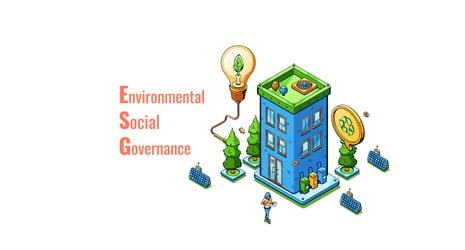Decarbonizing Construction: An Emerging Opportunity
Decarbonization is a global trend that construction players can’t afford to ignore. With the construction industry accounting for more than 20% of total global greenhouse gas emissions, construction companies have an opportunity to reduce their climate impact by decarbonizing construction processes. To seize this opportunity, construction players must view ESG as a strategic priority and collaborate with other stakeholders in the ecosystem including clients, architects, engineers, manufacturers, and financiers.
Measuring Impact on the Environment
 Construction is a major contributor to environmental impacts, accounting for approximately 20% of global emissions.
Construction is a major contributor to environmental impacts, accounting for approximately 20% of global emissions.
Measuring construction’s impact on the environment can be challenging because there are so many different construction activities and materials that have varying degrees of environmental impact. For example, construction projects often produce hazardous waste during demolition, but may also save energy by using more material-efficient designs. There are four main types of construction impacts to consider: GHGs (greenhouse gases), air quality, water use/quality, and solid waste generation. These categories can help guide your measurement strategy in terms of what you measure and how you measure it. Here are some specific metrics that might work well depending on which category you choose to focus on: metric tons of construction waste, construction water use intensity (gallons/gross square foot), indirect GHGs resulting from construction activity.
Building performance is also related to the environmental impact of construction because it can affect how much energy a building uses or doesn’t use over time—and therefore its carbon footprint. For example, if an office building has good insulation, it will maintain lower temperatures in the summer and winter which can decrease its energy use. The impact of construction should be measured throughout a building’s life cycle—from construction through disposal.
The construction ecosystem is driving global emissions.
Construction is a large and growing source of global carbon emissions, accounting for an estimated 8% of total anthropogenic GHG emissions. With construction output now expanding faster than any other major sector in the world, construction’s contribution to climate change could rise from 8% today to as much as 14-17% by 2050. Construction's share of global energy use has been increasing steadily since 2000, with buildings alone responsible for about 40% of construction-related energy consumption. The construction industry, therefore, offers a prime opportunity for decarbonization efforts—but only if players within this ecosystem view ESG issues as a vital business priority and collaborate more closely with stakeholders outside their traditional sphere of influence.
A recent report published by the World Green Building Council shows that construction sector emissions have already started to decline in some mature markets, with several countries achieving declines of more than 40% over the past 20 years. With construction output now expanding faster than any other major sector in the world, construction’s contribution to climate change could rise from its current level of about 12% to as much as 17 percent by 2050. Construction's share of global energy use has been increasing steadily since 2000, with buildings alone responsible for about 40 percent of construction-related energy consumption. The construction industry, therefore, offers a prime opportunity for decarbonization efforts—but only if players within this ecosystem view ESG issues as a vital business priority and collaborate more closely with stakeholders outside their traditional sphere of influence.
Decarbonization can be cost-effective.

Decarbonization is an opportunity for construction. The construction industry can reduce its carbon footprint if it embraces environmental sustainability. Some of the ways this can be done are to use less carbon-intensive construction materials, take into account climate vulnerability in construction design decisions, and adopt energy-efficient processes like prefab construction.
By embracing construction sustainability, construction can reduce its carbon footprint and contribute to a more sustainable world.
Construction companies can save money by reducing their carbon footprint. The construction sector is responsible for approximately 10% of global greenhouse gas emissions, with some construction activities emitting more than others. For example, construction of a new building requires the use of materials that are manufactured and shipped from all over the world before construction even begins—and then there are construction-related emissions associated with onsite work like excavating and pouring concrete. Meanwhile, demolition projects require significantly fewer emissions because they tend to be less labor-intensive than constructing new buildings—but they still emit significant amounts of CO2 during deconstruction processes like cutting steel beams or chipping away at cement slabs with jackhammers. All told, it’s estimated that construction accounts for up to 40% of greenhouse gas emissions in rapidly urbanizing regions with construction sectors that lack the efficiencies and technologies to reduce their carbon footprints.
There are many ways construction companies can cut back on these emissions, including:
- Using more prefabricated materials instead of products manufactured exclusively for construction projects;
- Building designs with passive heating and cooling systems to reduce the construction companies' dependence on fossil fuels;
- Promoting building designs that minimize construction waste.
- Include more ESD materials in construction projects to reduce the carbon footprint of buildings and other construction activities. These include:
- No or low VOC paints and coatings;
- Recycled content material such as cement, steel, and wood;
- Low energy equipment like LED lighting – even construction equipment like jackhammers and construction cranes.
Companies stand to benefit from tackling emissions
 Companies can benefit from construction projects that consider environmental factors. Construction companies will be able to save money over the long term by building more sustainable buildings with reduced emissions due to participating in certification programs. They would also have a reduced risk of climate change as they plan for construction projects considering all possible outcomes, including those brought about by climate change.
Companies can benefit from construction projects that consider environmental factors. Construction companies will be able to save money over the long term by building more sustainable buildings with reduced emissions due to participating in certification programs. They would also have a reduced risk of climate change as they plan for construction projects considering all possible outcomes, including those brought about by climate change.
Companies involved in construction would be able to participate in the emerging carbon credit market, which could bring about more revenue from construction projects as environmental concerns become a bigger priority for companies around the world.
More opportunities may open up if construction players can collaborate with other stakeholders
The construction industry's chance of fully capitalizing on the construction opportunities drops significantly if they don't coordinate with other stakeholders in the construction industry.
In addition, construction companies would miss out on a potentially large new market. With the increasing demand for carbon credits and environmental sustainability initiatives around the world, there is potential that construction projects could contribute to this growing green economy—if construction players work with companies in other construction-related industries to achieve their shared goals.
- For construction players to fully seize the benefits of decarbonization initiatives, they will need to collaborate with a variety of stakeholders from across the construction industry ecosystem—including investors and government agencies.
Involving financial institutions could open up investment opportunities
Collaborating with financial institutions could also open up construction opportunities—and construction players will need to be part of the conversation. Construction companies that invest in renewable energy projects are already seeing returns on their investments, but this is just one way that construction can benefit from ESG initiatives. Other ways include increasing demand for green buildings and construction products and opening up new markets.
As more construction players look to invest in green buildings and energy-efficient construction projects, they will need capital from financial institutions that understand the long-term potential of these opportunities.

Financial institutions can help provide this capital through their investments in infrastructure funds and construction companies with ESG-friendly construction projects may be able to attract more of these investments.
Collaborating with government agencies could help construction players achieve their goals.
For construction companies to fully benefit from the opportunities presented by ESG initiatives, they will need to work closely with governments and other policymakers around the world and ensure that these policies are in place. This could include governments developing construction guidelines that take the environment into account when building construction projects, which construction companies would then need to adhere to when pursuing these opportunities.
Collaborating with government agencies may also involve construction players advocating for policies and regulations in their countries that support ESG initiatives in construction—potentially including connecting construction companies with other construction players and investors who can help them push forward these initiatives.
Construction companies operating in the United States may be able to leverage their influence within government agencies to advocate for policy changes that could benefit construction projects and potentially bring about more revenue from green building opportunities.

Collaborating with a variety of construction industry players could help construction companies seize the benefits of decarbonization initiatives.
Topics from this blog: Research and Reports For Architect
Back